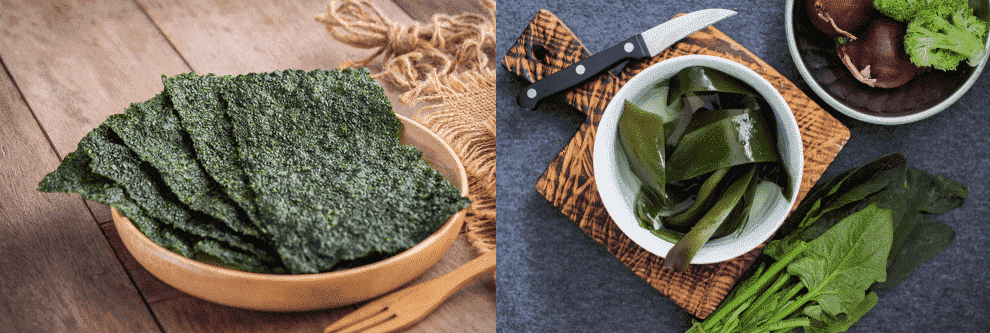
Food is the best thing that ever happened to the foodies, right? So, if you have a knack for Japanese food, you would know that seaweed is an important part of the cuisine. With this being said, the two most important seaweed types for Japanese food are Kombu and Nori. They are integrated with multiple minerals and vitamins. So, if you aren’t sure about the differences, we have added Nori vs. Kombu in this article!
Nori vs Kombu
Nori
Nori is the seaweed that’s usually made edible by laying them out on thin sheets under the sun. The sheets must be laid on the wooden frames. Nori is sold in crispy sheet form, and one needs to make sure that they put Nori dry, or else, it will go softly. Nori is commonly used in breakfast when it’s wrapped in rice and devoured with soy sauce.
Some people also wrap it around the fish and veggies, which makes it the norimaki-zushi. Similarly, there is o-chazuke, which is made with a bowl of rice and has shredded Nori o the top. Nori is a seamless form of mild tranquilizer and calcium, which starts the day in the most relaxing way. Nori has a lighter color gradient, while the texture is a crispy texture.
One cannot immerse Nori in water because it ruins the flavor, which means it must be kept dry at all times. Nori is rich in proteins that are responsible for optimizing the tissues. They are rich in Vitamin B1 and Vitamin A, which enhances immunity and eyesight. In addition, it’s rich in zinc, iron, calcium, vitamins, and proteins.
Nori is also farmed around Japan and China. Their spores are planted in the net during January and are then harvested during the autumn season. It is usually washed in cold water, and the sun is used for drying purposes. Once the Nori is dried, it is cut into thin sheets and stored in the plastic bag. In some cases, it is flavored with soy sauce and mirin for creating different versions.
Nori is usually used at the sushi restaurants for wrapping rice and sushi. However, it is not cooked because it can be used in the natural state, dry and crispy.
Kombu
Kombu is the kelp which is usually sold in the dried and thick form and has a black strip appearance. It is usually immersed in water before use to make it soft. Kombu is usually used to make soup stock, commonly known as dashi. Some people also simmer the Kombu with soy sauce, cooking sake, and additional flavors for making boiled dishes.
Kobu-maki is usually made with the herring wrapping and simmered fish. Also, people tend to soften the Kombu in vinegar and are shredded to make Tororo-kombu. For those who don’t know, Kombu is usually made for New Year since it’s known as the good luck dish. When Kombu is sold, it usually has a dry appearance and is sold in sheet form.
The texture is usually dry and thick, and the color is nearly black (pretty dull). Kombu is rich in calcium, which makes it a fine choice for people who need to optimize bone health. In addition, it has soluble fiber that enhances metabolism and is beneficial for constipation. In some cases, it helps with weight loss and bowel movement.
Kombu is rich in iron, which can protect from fatigue and aids in curing the shortage of breath. It is rich in minerals, such as magnesium and zinc, which helps enhance the organ functions and immunity. On top of everything, it has different vitamins, such as Vitamin B, C, D, and Vitamin D, which promises better health. Kombu is usually harvested in Hokkaido’s shallow waters, along with different shores of China and Japan.
The Bottom Line
Nori and Kombu, both of them, are majorly used in the Japanese cuisines. Both of them are grown and harvested around China and Japan. However, their utilization is pretty different. This is because Nori is used in the dry sheet form, but you need to soften the Kombu in water or vinegar, depending on the recipe (for softening it). In addition, Kombu has an almost black appearance, while Nori has a light color gradient. So, which is your right fit?
